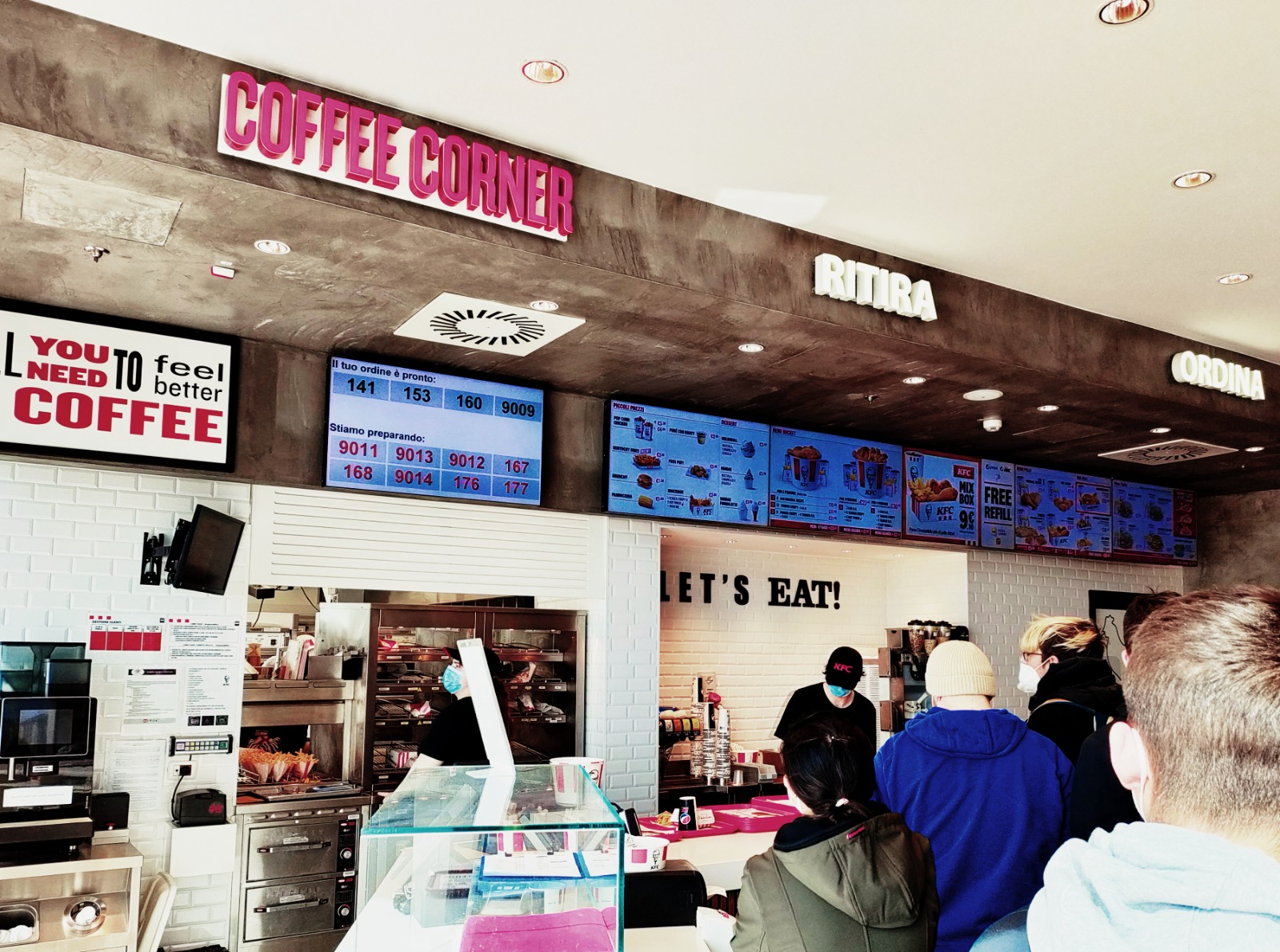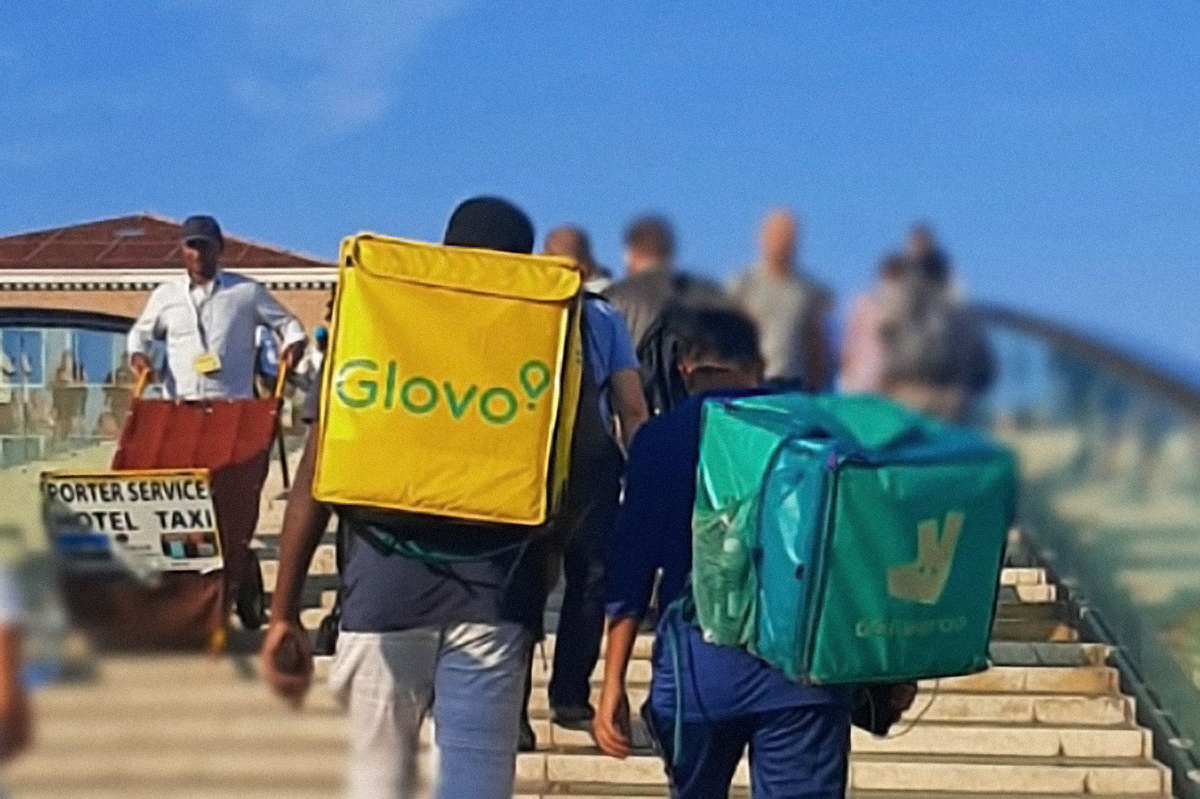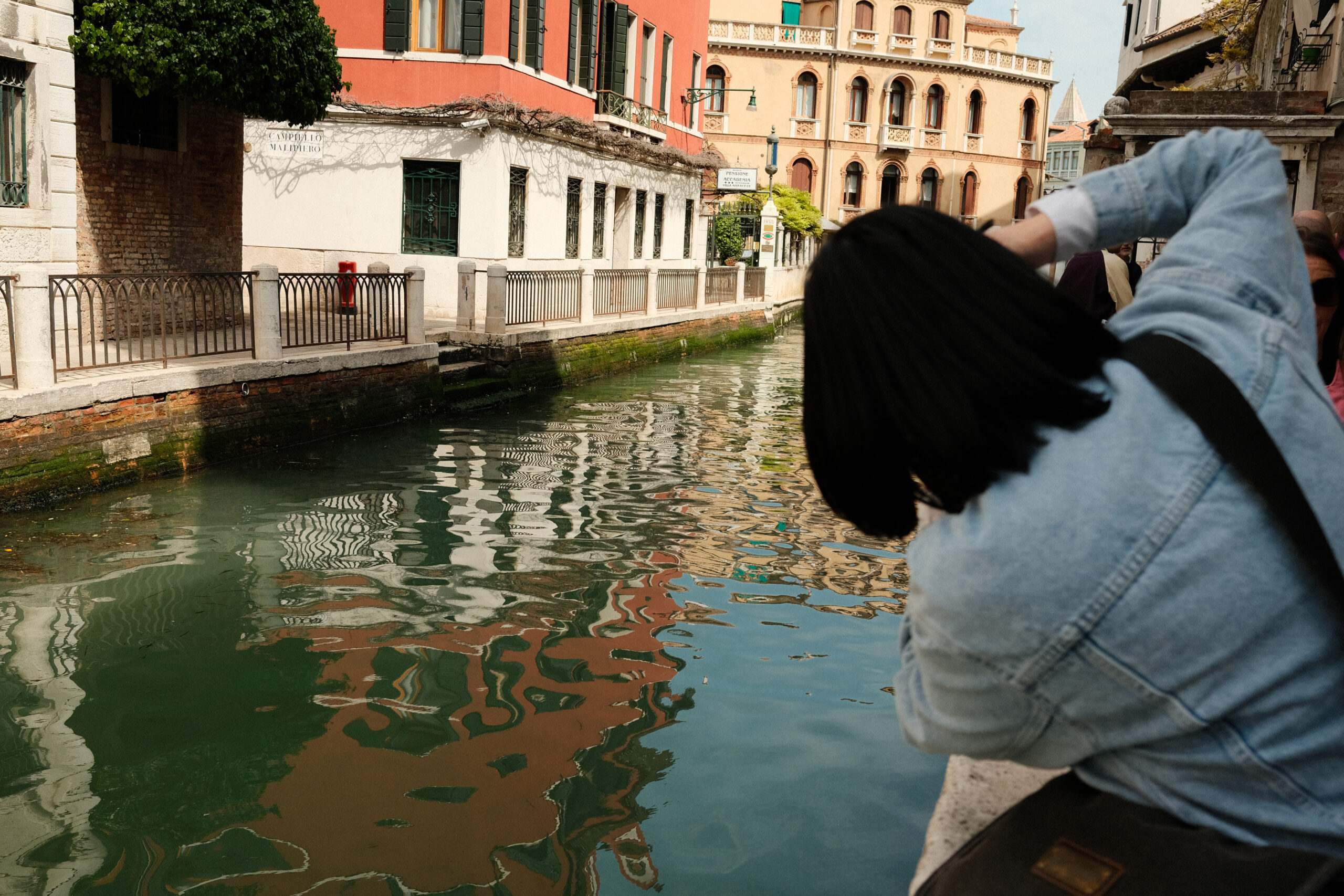
Reports from a Venetian walker
Venice is perhaps the only city in the world where food can only be delivered on foot. Recounting his experience as a delivery “walker”, Giorgio Pirina traces a fresco of his daily shifts, caught between digitalised work and timeless sites, with the liberating experience of walking contrasting with the impact of mass tourism and the demands of the gig economy.
The following text is a story of Venice – the fruit of a research project on the contemporary temporalities, work-life balance and daily routines of digitalised services workers. It is recounted by means of a “pop-up enthography”, that is to say, texts with an impressionist-descriptive style in relation to the spectrum of emotions evoked by they landscape in which I was immersed.
More specifically, this text represents a glimpse into the everyday life of a walker, a courier for a home delivery app. In Venice they are walkers, not riders, since the city’s geography does not permit the use of other forms of transport, only ones own legs.
Venice is an atypical city for many reasons: the particular way in which daily life unfolds for the locals, its architectural structures, its shape (seen from above it looks like a fish), and the very place where it is built–the centre of a 550 square kilometres lagoon.
The traveller who is unfamiliar with this city, who has only heard about it or has simply seen pictures of it cannot imagine what it is like to live and walk through the alleys of Venice, crossing the hundreds of bridges that serve as a connecting weave for the people who crowd the city every day.
Just think of the toponymy. It differs from that of any other city (the only exception being Chioggia – a nearby town). First of all, the historic centre is divided in half by the Grand Canal, Venice’s main waterway, along which are some of the city’s most beautiful buildings, dating back to the 12th century.
In Venice, there is no such thing as the street, the alley, the avenue, the square; instead you have the calle, the salizada, the rio terà, the campo, the fondamenta, the bridges, the piscine, etc. There are only three exceptions, which confirm the rule: Via Garibaldi, Via XXII Marzo and Piazza San Marco.
All these different terms for what in other cities would simply be ‘streets’ or ‘roads’ derive from the functional nature that characterised the construction of Venice: for instance, calle is of Latin derivation and means path (from callis), while salizada derives its name from the material with which the street was made – the salizzo, or flint.
The rio terà, on the other hand, is a road built from a filled-in canal. This toponymy occurs on all the islands that make up the Venetian archipelago, with the exception of Lido, whose urban structure is no different from any other city.
The historic centre of Venice is organised into six sestieri (Cannaregio, Castello, Dorsoduro, San Polo, Santa Croce and San Marco), consisting of dozens of islets connected by about 400 bridges. The civic numbering reflects the eccentricity of the city: unlike standard city schemes in which numbering continues linearly for the buildings on a street, in Venice, numbers are assigned starting from a specific point of each sestiere and then progressing concentrically to retrace the road back to its starting point.
The fact that many people get lost along Venice’s calli and that GPSs are not always accurate also stems from this reason. This structuring of Venice has significant impacts on how the work of a walker is carried out, as well as on the array of sensations and emotion they might experience.

Image by Francesco Della Puppa. Top image by Giorgio Pirina.
An intertwining of workplaces
A walker’s job begins as follows: logging into the app, checking-in from 25 minutes before the booked time slot, waiting for an order, receiving the notification of an order and accepting it – or reassigning it to another walker, a choice that negatively affects a walker’s ranking.
Once the order is accepted, you just have to follow the trajectory: departure, point-pick-up point, delivery point. But as I walk along this route, I have to deal with people, architecture, technology (for example, the app and its possible malfunctions; the internet connection that doesn’t work well; the GPS), bars and restaurants, bacari and shops.
To varying degrees of intensity and consciousness, my senses become activated (including the sixth, particularly useful for predicting which calle will be more crowded and selecting an alternative route) to grasp, in detail, the plethora of micro-events happening around me.
So far, pick-up points in Venice have always been multinational restaurant chains and fast-food outlets, as well as eateries that combine pizzerias with kebab joints. Working as a walker allowed me to become a first-hand observer a part, albeit partial, of the organisation of work in the kitchens of these establishments. This inside-outside perspective meant that I could notice aspects that, as a customer, tend to be less evident or have little relevance because of one’s urge to consume.
If I may use a theatrical metaphor (proscenium for customer’s lounge, backstage for kitchen), the wait times for picking up an order, which in some cases is several minutes, allow me to peer into what goes on behind the scenes of these fast food restaurants, sensing the moods of those who work behind the counter and grasping the varied atmospheres that are not immediately accessible to Venetian customers: from the beeps of the semi-automated fryers signalling that the chips are ready; the sizzle of the meat cooking on the plates; the smell of the food pervading the space; to the sound of tills; the chatter of customers; and the waitress shouting ‘”number 78!” and getting impatient as no customer comes to collect the food (one minute in a work organisation such as fast food can feel like an hour).
In some cases the working pace is extremely fast, even when there seems to be some automation of the work process in place. Apart from a few exceptions, fast food restaurants in Venice are not spacious, either on the customer side or on the kitchen side. On the contrary, they are cramped to the point that, when busy, it is difficult to even get through: in this respect, automatic cashiers do not seem to be of much help, as queues still appear to almost overlap.
On several occasions, I met other walkers who were irritated by the overall waiting times. Although partly compensated for (but only with 0.05 cents per minute!) it represents a potential loss of earnings which would certainly be greater with a delivery.
However, I should highlight that, despite having to navigate through such tight rhythms and spaces, fast food workers have always been empathetic with me as a walker – or at least compliant – even when I was late, or coming from an inconvenient departure point, with the order sitting there waiting for me.
Customers behaved similarly when I would follow the wrong route due to incorrect GPS location and therefore being late. One customer in particular stuck with me: she phoned me, and decided to come my way to meet me as “unfortunately I know that Maps works badly here in Venice”.

Image by Giorgio Pirina.
Resting at “Zattere”
Once done with my walker morning shift for a well-known delivery app, and after covering about 22-24km on foot, on my way home I decide to stop to rest at the Zattere, one of the most picturesque places in Venice, overlooking the Giudecca canal. It is about five o’clock in the afternoon on a January Monday, with the evening now coming down and the sun progressively hiding behind the neo-Gothic architecture of the Giudecca island.
It is a beautiful winter day and, although these being the so-called “the days of the blackbird” in Italian – supposedly the coldest of the year – the weather is mild, almost spring-like. As I sit, with the odours of the lagoon pervading the air carried by a light sea breeze, the bright blue of the sky slowly gives way to the more enveloping reddish hues of winter sunsets on clear days.
Zattere is a place that most conveys the uniqueness of Venice, this city-archipelago at once lagoon, artistic haven and industrial centre. The reddish hues are interspersed with the passage of a flock of cormorants – circling and drawing bewitching choreographies in the sky.
Below them, the calmness of the water is broken by the incessant passage of vaporettos and boats, with the briccole – the wooden nautical structures used to indicate the boundaries of waterways – increasingly consumed by this marriage of air and water, but still resisting the constant pounding of waves.
In the distant background are the chimneys of the Marghera petrochemical plant, the largest industrial centre in Northern Italy, built in 1917 by filling-in what were once seaside areas, now covering more than 2000 hectares. In front of me are the two islands of Giudecca and Sacca Fisola, with the former Molino Stucky – a neo-gothic building, once flour mill and pasta factory and now transformed into the Hilton Hotel – and the Fortuny palace, a fabric production site.
Looking further to the right is Santa Marta with its university campus and school of architecture, whereas looking further to the left is the church of the Santissimo Redentore, connected to its mother island every July by the so-called votive bridge, a temporary footbridge first constructed in 1577, once entirely made of boats tied together, which today relies on wood planks that rest on floating structures.
Finally, behind me, and beyond the palazzine that house flats, hotels and university lecture halls, is the intricate web of calli, campi, bridges, canals and architectural structures teeming with artisan workshops and fountains, that forms this complex city. The view experienced by a walker resting on a Zattere bench, therefore, recounts the thousand-year history of Venice.
In that moment of respite from the ever-tighter rhythms of today’s gig economy, the view experienced by a walker sitting at the Zattere recounts a stark contrast with the thousand-year history of Venice, at the heart of which, even before sailing, there is walking, and therefore the potential for radically different ways of life.

Image by Matteo Cavallaro.
“Zombification” and re-humanisation
Something I notice as a walker – perhaps even thanks to my personal nostalgia which has heightened my sensitivity – is a constant, interstitial yet hidden tension within Venice, between a zombifying tourism and the fragile but re-humanising beauty of the lagoon city-archipelago.
During my delivery walks, I read, feel, see, in the signs, in the chatter, in the daily lives of Venetians, the virus that acts in the body of the city: it debilitates it by attacking its organism and extruding its vital cells – those who inhabit and live in Venice by weaving non-ephemeral social relationships. Just as the undead follow the scent of living human flesh, so do tourists wander in search of a view or memory to capture and take with them.
Venetian architecture – as intricate and elegant to the eye as it is rigid and angular – strikingly materialises this tension by channelling, with the grace and indifference befitting aristocratic elegance, the throngs of people along the web of narrow calli and bridges.
This, however, often obstructs the passage of Venetians and workers (be they gig-economy walkers or deliverymen with carts) spurred by daily schedules that are at odds with those of tourists. Not surprisingly, this scenario contributes to shaping a distinct aspect of the city’s daily soundscape: it is not uncommon, in fact, to have to assertively exclaim “permesso” (“excuse me”) in order to make ones way through the crowds.

Image by Matteo Cavallaro.
After all, those who do not live in Venice are unaware of an unspoken practice: to walk in an orderly manner and in a line, keeping to the right, so as not to overcrowd the calli. Often GPS does not help, as it simply indicates the shortest route and, moreover, is the same tool that tourists use.
The traffic jams that are created are certainly problematic for walkers, as they slow down their travel times and consequently the number of deliveries made, thus reducing daily profit. I sometimes (and whenever possible) overcome these problems with prior knowledge by taking alternative routes, although the increased length of the journey is not covered by the app’s remuneration system.
I try to put myself in the shoes of my foreign colleagues who live in Mestre and therefore perhaps do not yet know Venice well: how do they experience these difficulties? What strategies do they use to get around them?
On a few occasions I have happened to ‘accompany’ other walkers during work, and the rush against time to deliver on schedule and limit the loss of earnings produced by the overcrowding of the calli has often resulted not in walking, but in brisk marches. Not infrequently I would see them ‘jostling’ to overtake tourists who had stopped on bridges or along the calli to take photos and selfies, repeatedly static in the city made for walking.
Although the tension between zombifying tourism and re-humanising beauty may appear to be a dichotomy, it is in fact a mutual relationship, since it is beauty itself that attracts the zombifying viral agent, which in turn has bewitched and beguiled. Like Circe the Sorceress with Ulysses, Venetians undergo a surreptitious and devious but, nonetheless actual, enchantment.
Yet, the lagoon city resists by trying to re-humanise its fabric thanks to the inhabitants who are aware of its beauty, its fragility, its uniqueness. It seems paradoxical, with my delivery backpack now empty and the app finally silent, reminding myself that, at the very heart of this resistance, the very first thing they do is walk.
Recent articles

Southern California is many things. Quite infamously, it is known as a landscape defined by the automobile, from the emergence and diffusion of the highway system to fast food burgers, and the suburbanization of the United States. Walking this place then, would seem not only inconvenient, but ill advised. In… Read more »

What is today known as ‘whistleblowing’ could once take the form of interacting with a threatening gaze carved into the city wall. It is the case of the ‘boche de Leon’ or ‘lion’s mouths’ disseminated by the old Venetian Republic throughout its territory to suppress illegal activities. Through a close… Read more »

As he navigates through the recurrent lockdowns of the pandemic, stranded between hitchiking and muggings, job hunting and separations, Fabio Valerio Tibollo rediscovers photography as a powerful coping mechanism. Recording everything that happened around him for one year straight, from attending momentous events to finding curiosity in shots of simple living,… Read more »

